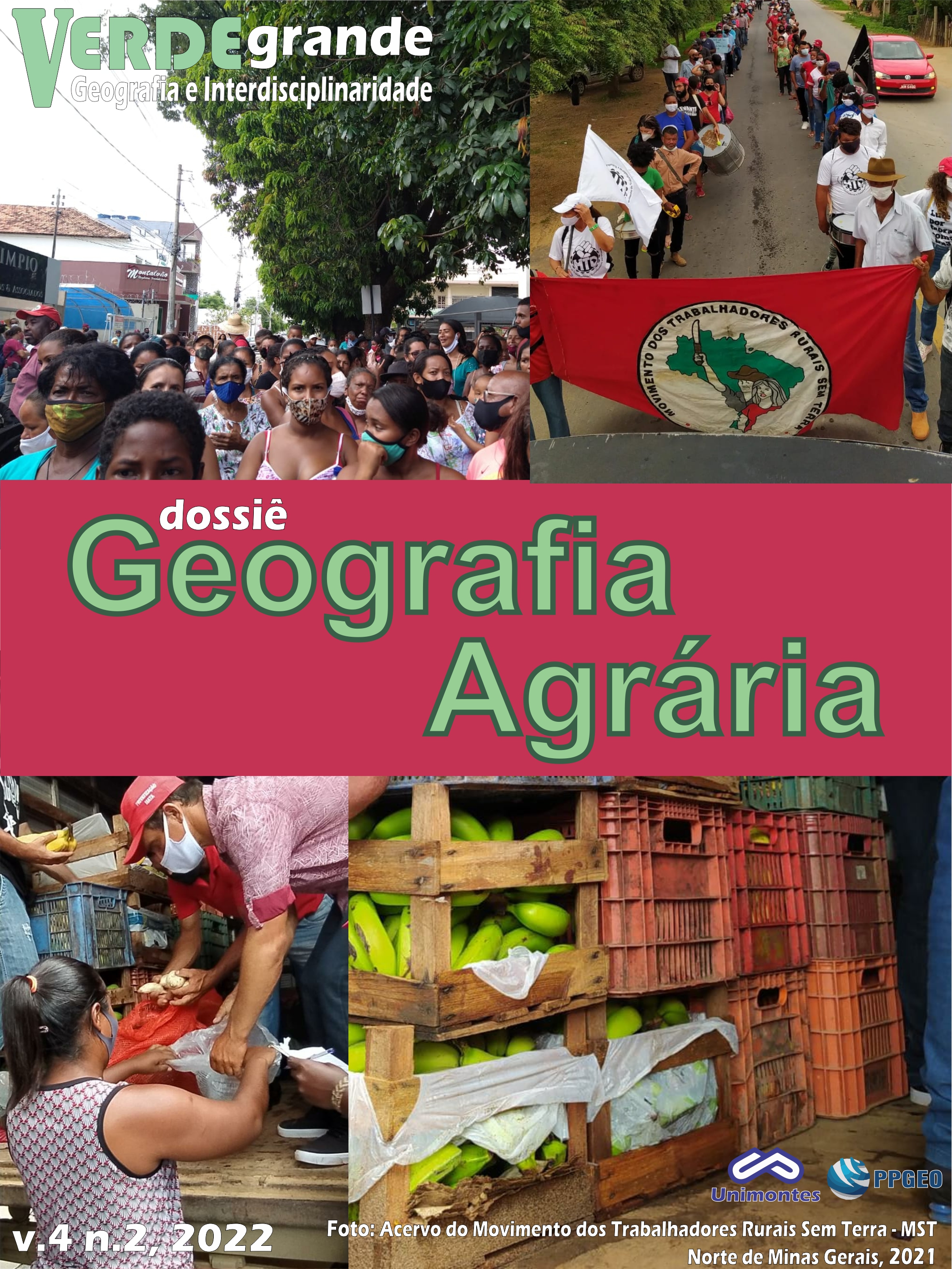ANALYSIS OF THE RELATIONSHIP OF THE GINI INDEX AND THE ENVIRONMENTAL CONFIGURATION IN THE MUNICIPALITIES OF WESTERN BAIANO BASED ON DATA FROM THE MODIS ORBITAL SENSOR FOR THE YEAR 2019
DOI:
10.46551/rvg2675239520222256274Keywords:
Sensoriamento Remoto, Processamento Digital de Imagens, Concentração de terrasAbstract
The West of Bahia is characterized as a region marked by agribusiness and the expansion of new agricultural frontiers; on the other hand, this same region is also characterized by high concentrations of land, on which the Gini index (GI) is used in this study to measure this socioeconomic phenomenon and its socio-environmental repercussions. Therefore, this article aims to analyze and discuss the relationship between the GI, the use and land cover in this region, based on images from the Moderate-Resolution Imaging Spectroradiometer (MODIS) sensor. Using Remote Sensing and Digital Image Processing techniques, it was possible to identify the main characteristics and environmental configurations of the areas, based on the land concentration measured by the GI.
Downloads
References
ALCÂNTARA FILHO, J. L.; FONTES, R. M. O. A formação da propriedade e a concentração de terras no Brasil. Revista de História Econômica e Economia Regional Aplicada, v. 4, n. 7, jul./dez. 2009.
ALENTEJANO, P. A. A centralidade da questão fundiária no cenário agrário brasileiro do século XXI. In: ENCUENTRO DE GEOGRAFOS DA AMERICA LATINA, 15, 2015. Anais... La Habana: Facultad de Geografia de la Universidad de La Habana; Sociedad Cubana de Geografia, 2015, v. 1, p. 1-21.
BERTRAND, G. Paisagem e geografia física global: esboço metodológico. Caderno de Ciências da Terra, n. 13, p. 1-27, 1971.
CÂMARA, L. A concentração da propriedade agrária no Brasil. Boletim Geográfico, Rio de Janeiro, v. 7, n. 77, p. 516-528, 1949.
CARVALHO, H. M. Política compensatória de assentamentos rurais como negação da reforma agrária. Revista Adusp, São Paulo, n. 34, p. 30-38, 2005.
CHRISTOFOLETTI, A. Modelagem de sistemas ambientais. São Paulo: Edgard Blucher, 1999.
DELGADO, G. C. A questão agrária e o agronegócio no Brasil. In: CARTER, M. (Org.). Combatendo a desigualdade social: o MST e a reforma agrária no Brasil. São Paulo: Editora Unesp, 2010.
ENVIRONMENTAL SYSTEMS RESEARCH INSTITUTE. 2017. Disponível em: <https://www.esri.com/pt-br/home>. Acesso em: 15 abril. 2022.
FLORENZANO, T. G. Iniciação em sensoriamento remoto. 2. ed. São Paulo: Oficina de Textos, 2007.
HOUET, T. et al. Inductive pattern-based land use/cover change models: a comparison of four software packages. Environmental Modelling & Software, p. 94-111, 2014.
ITRIA, A. A relação inversa entre o preço e a dimensão da propriedade rural em mercados específicos. Dissertação (Mestrado em Desenvolvimento Econômico, Espaço e Meio Ambiente) — Universidade Estadual de Campinas, Instituto de Economia, Campinas, 2004.
JENSEN, J. R.; EPIPHANIO, J. C. N. Sensoriamento remoto do ambiente: uma perspectiva em recursos terrestre. São José dos Campos: Parêntese, 2009.
MATOS, J. D. Distribuição de renda: fatores condicionantes e comparação entre as regiões metropolitanas pesquisadas pela PED. Porto Alegre: Fundação de Economia e Estatística Siegfried Emanuel Heuser, 2005.
NATIONAL AERONAUTICS AND SPACE ADMINISTRATION. 2017. Disponível em: <https://www.nasa.gov/>. Acesso em: 18 mar. 2022.
SANTOS FILHO, A. M.; RIOS FILHO, J. N. V. A revalorização econômica do Oeste baiano a partir da expansão da agricultura moderna e o surgimento de um novo território: o município de Luís Eduardo Magalhães/BA. Pegada, v. 9, n. 2, dez. 2008.
SOUZA, P. M. Modernização e mudanças estruturais na agricultura brasileira, de 1970 a 1995. Tese (Doutorado em Economia Rural) — Universidade Federal de Viçosa, Viçosa, 2000.
UNITED STATES GEOLOGICAL SURVEY. 2017. Disponível em: <https://www.usgs.gov/>. Acesso em: 21 fev. 2022.
XIAN, G., CRANE, M. Assessments of urban growth in the Tampa Bay watershed using remote sensing data. Remote Sensing of Environment, n. 97, p. 203-215, 2005.
Downloads
Published
How to Cite
Issue
Section
License
Copyright (c) 2022 Luciel Passos de Oliveira, Uilmer Rodrigues Xavier da Cruz

This work is licensed under a Creative Commons Attribution-NonCommercial-NoDerivatives 4.0 International License.
You are free to:
Share — copy and redistribute the material in any medium or format
The licensor cannot revoke these freedoms as long as you follow the license terms.
Under the following terms:
Attribution — You must give appropriate credit, provide a link to the license, and indicate if changes were made. You may do so in any reasonable manner, but not in any way that suggests the licensor endorses you or your use.
NonCommercial — You may not use the material for commercial purposes.
NoDerivatives — If you remix, transform, or build upon the material, you may not distribute the modified material.
No additional restrictions — You may not apply legal terms or technological measures that legally restrict others from doing anything the license permits.


















 Esta obra está licenciada com
Esta obra está licenciada com 